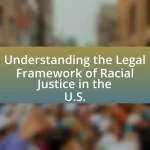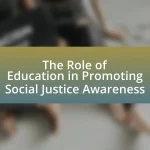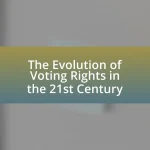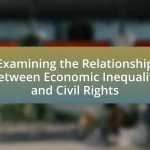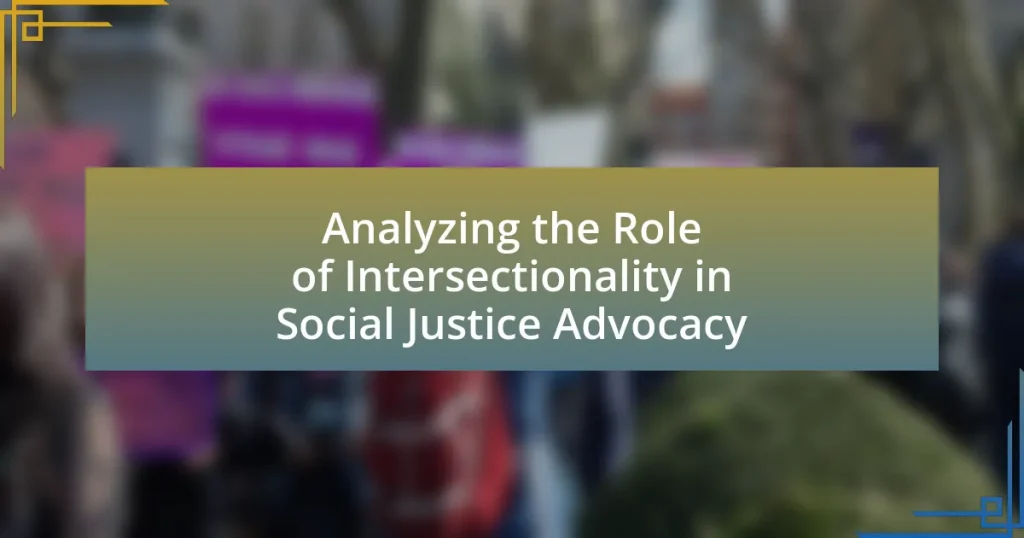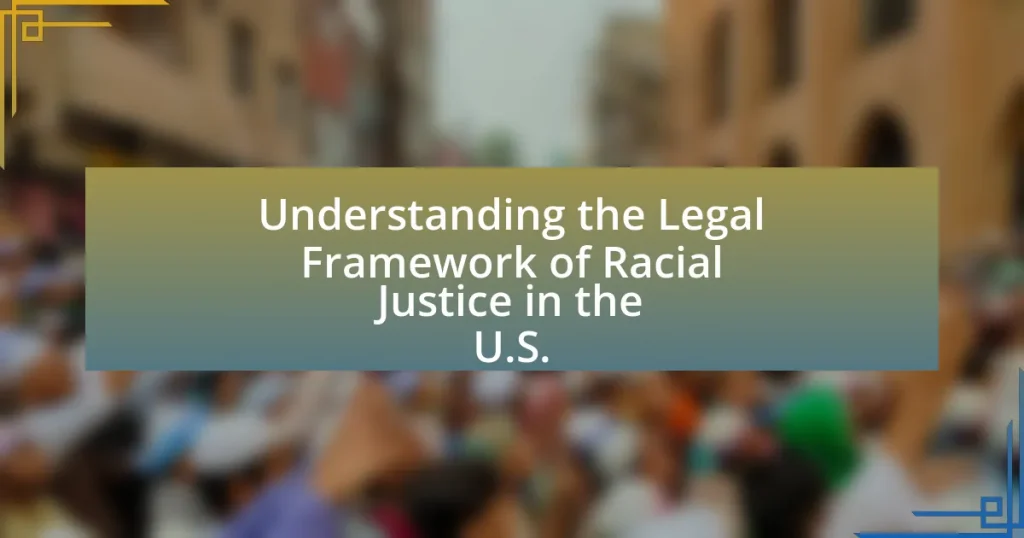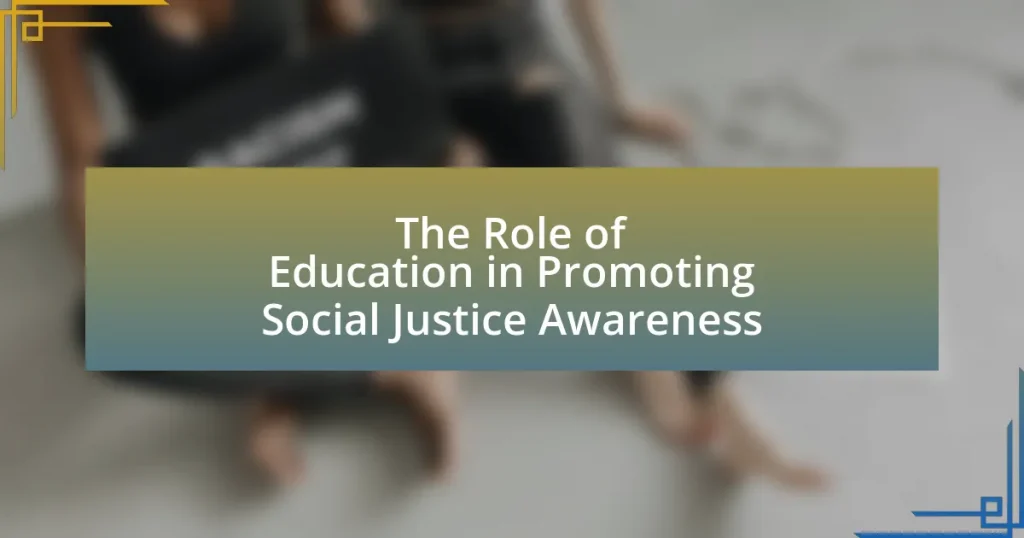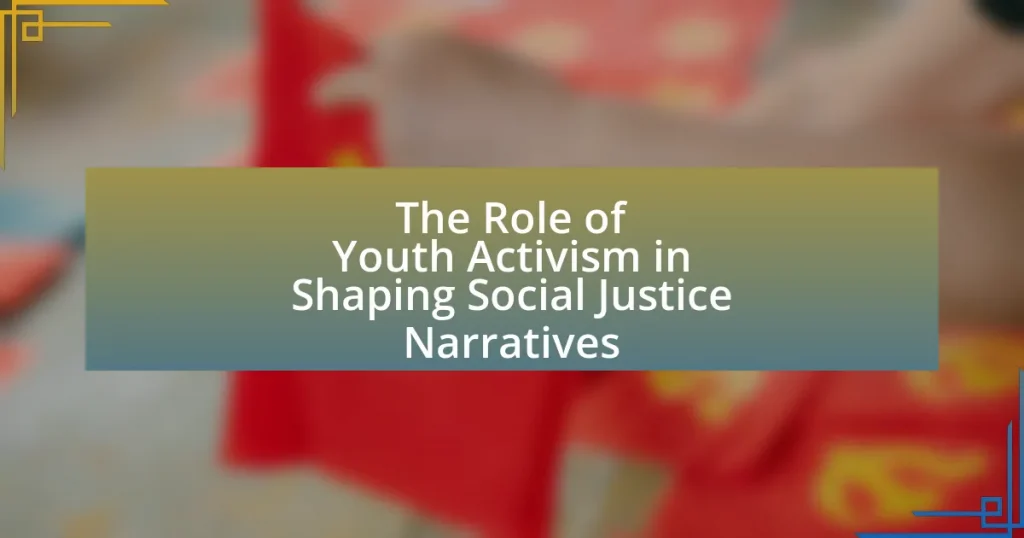The article analyzes the role of intersectionality in social justice advocacy, a framework that examines how overlapping social identities—such as race, gender, sexuality, and class—interact to create unique experiences of discrimination and privilege. It discusses the emergence of intersectionality through Kimberlé Crenshaw’s foundational work, key historical events that shaped its understanding, and prominent figures who contributed to its development. The article emphasizes the importance of incorporating intersectionality into advocacy strategies to address systemic inequalities effectively, while also highlighting the challenges and misconceptions associated with this approach. Additionally, it outlines best practices for enhancing intersectional advocacy, including community engagement and continuous education.
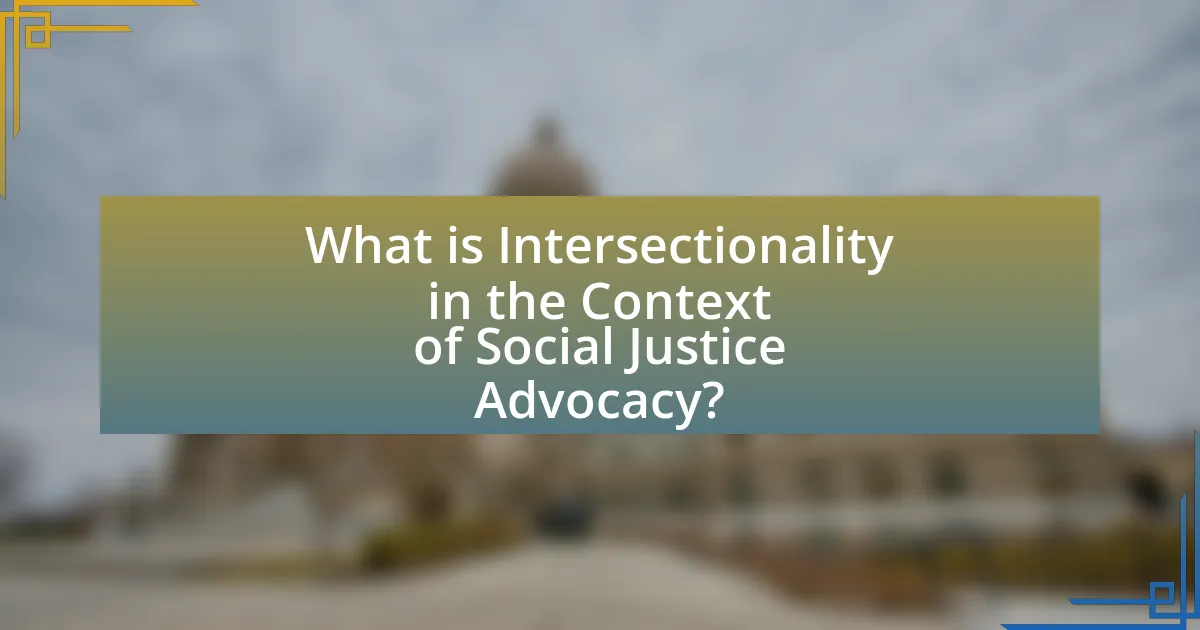
What is Intersectionality in the Context of Social Justice Advocacy?
Intersectionality in the context of social justice advocacy refers to the framework that examines how various social identities, such as race, gender, sexuality, and class, intersect to create unique modes of discrimination and privilege. This concept, introduced by Kimberlé Crenshaw in 1989, highlights that individuals experience oppression differently based on their overlapping identities, which can compound systemic inequalities. For example, a Black woman may face both racial and gender discrimination simultaneously, which cannot be fully understood by examining race or gender in isolation. This understanding is crucial for effective advocacy, as it emphasizes the need for inclusive strategies that address the complexities of individuals’ lived experiences, thereby fostering a more equitable society.
How did the concept of intersectionality emerge in social justice movements?
The concept of intersectionality emerged in social justice movements primarily through the work of Kimberlé Crenshaw in the late 1980s. Crenshaw introduced the term to highlight how various forms of social stratification, such as race, gender, and class, intersect to create unique experiences of oppression. Her analysis was rooted in the limitations of traditional feminist and anti-racist frameworks, which often failed to account for the complexities faced by individuals at the intersections of multiple identities. This foundational work was exemplified in her 1989 paper “Demarginalizing the Intersection of Race and Sex,” where she argued that legal and social systems inadequately addressed the needs of those who experience overlapping forms of discrimination. The concept gained traction in subsequent social justice movements, influencing activism and scholarship by emphasizing the importance of recognizing and addressing these intersecting identities in the fight for equity and justice.
What are the key historical events that shaped the understanding of intersectionality?
The key historical events that shaped the understanding of intersectionality include the publication of Kimberlé Crenshaw’s 1989 paper “Demarginalizing the Intersection of Race and Sex,” which introduced the term and concept of intersectionality, highlighting how overlapping social identities impact experiences of oppression. Additionally, the Combahee River Collective’s 1977 statement emphasized the importance of considering race, gender, and class in feminist discourse, laying groundwork for intersectional analysis. The 1991 Anita Hill hearings brought national attention to issues of race and gender in the workplace, further illustrating the need for an intersectional approach. These events collectively contributed to the development of intersectionality as a critical framework in social justice advocacy.
Who are the prominent figures associated with the development of intersectionality?
The prominent figures associated with the development of intersectionality include Kimberlé Crenshaw, Patricia Hill Collins, and Angela Davis. Kimberlé Crenshaw, a legal scholar, coined the term “intersectionality” in her 1989 paper, highlighting how overlapping social identities, particularly race and gender, create unique experiences of discrimination. Patricia Hill Collins expanded on these ideas in her work on Black feminist thought, emphasizing the interconnectedness of race, class, and gender. Angela Davis, an activist and scholar, has also contributed significantly to the discourse on intersectionality through her advocacy for social justice and her analysis of the prison-industrial complex, illustrating how various forms of oppression intersect.
Why is intersectionality important for social justice advocacy?
Intersectionality is important for social justice advocacy because it recognizes that individuals experience overlapping systems of oppression, which informs more effective advocacy strategies. By understanding how factors such as race, gender, class, and sexuality intersect, advocates can address the unique challenges faced by marginalized groups. For instance, a study by Crenshaw (1989) highlighted how Black women face discrimination that is not solely based on race or gender but on the combination of both, demonstrating that a singular approach to social justice fails to capture the complexities of their experiences. This nuanced understanding allows for more inclusive policies and practices that better serve diverse communities, ultimately leading to more equitable outcomes in social justice efforts.
How does intersectionality enhance the understanding of systemic inequalities?
Intersectionality enhances the understanding of systemic inequalities by revealing how various social identities—such as race, gender, class, and sexuality—interact to create unique experiences of oppression and privilege. This framework allows for a more nuanced analysis of how systemic structures, like racism and sexism, do not operate independently but are interconnected, leading to compounded disadvantages for individuals at the intersections of multiple marginalized identities. For example, research by Crenshaw (1989) highlights that Black women face discrimination that is distinct from that experienced by white women or Black men, illustrating that policies addressing only one aspect of identity may fail to address the full scope of inequality. Thus, intersectionality provides critical insights into the complexities of social justice issues, enabling advocates to develop more effective strategies for addressing systemic inequalities.
What are the implications of ignoring intersectionality in advocacy efforts?
Ignoring intersectionality in advocacy efforts leads to ineffective strategies that fail to address the diverse needs of marginalized groups. When advocacy does not consider the overlapping identities of race, gender, class, and other social categories, it risks perpetuating systemic inequalities and excluding voices that are crucial for comprehensive solutions. For instance, research by Crenshaw (1989) highlights how Black women face unique challenges that are not adequately addressed by feminist or anti-racist movements alone. This oversight can result in policies that do not reflect the realities of those most affected, ultimately undermining the goals of social justice and equity.
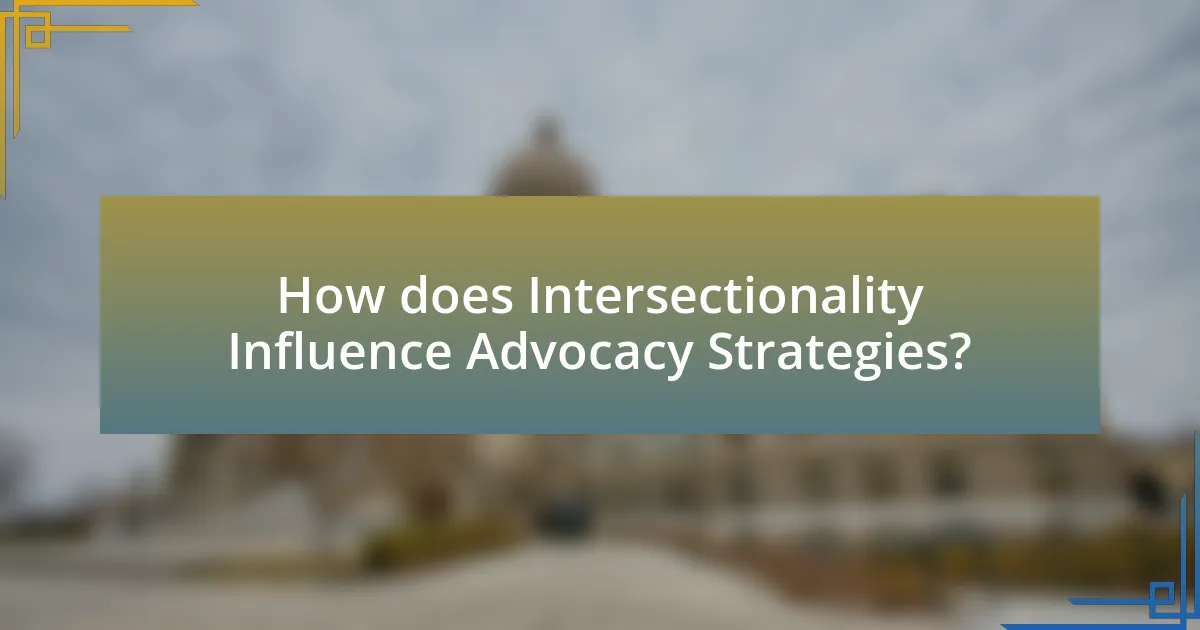
How does Intersectionality Influence Advocacy Strategies?
Intersectionality influences advocacy strategies by emphasizing the interconnected nature of social categorizations such as race, gender, and class, which can create overlapping systems of discrimination or disadvantage. This understanding allows advocates to tailor their strategies to address the unique experiences and needs of individuals who exist at the intersections of multiple identities. For example, research by Crenshaw highlights how Black women face distinct challenges that are not fully addressed by either feminist or anti-racist movements alone, necessitating advocacy that specifically targets their experiences. By incorporating intersectionality, advocacy strategies become more inclusive and effective, ensuring that marginalized voices are heard and that solutions are comprehensive.
What are the different dimensions of identity that intersectionality considers?
Intersectionality considers multiple dimensions of identity, including race, gender, sexual orientation, class, ability, age, and ethnicity. These dimensions interact to shape individual experiences and social positions, highlighting how various forms of discrimination and privilege overlap. For example, a Black woman may face unique challenges that differ from those experienced by a white woman or a Black man, illustrating the complexity of identity in social contexts. This framework is supported by Kimberlé Crenshaw’s foundational work, which emphasizes that understanding these intersecting identities is crucial for addressing systemic inequalities effectively.
How do race, gender, class, and sexuality intersect in social justice issues?
Race, gender, class, and sexuality intersect in social justice issues by creating unique experiences of oppression and privilege that affect individuals differently based on their identities. For instance, Black women face both racial and gender discrimination, which can lead to compounded disadvantages in areas such as employment and healthcare. Research by the American Psychological Association highlights that individuals who belong to multiple marginalized groups often experience higher rates of mental health issues due to systemic inequalities. Furthermore, the intersectionality framework, introduced by Kimberlé Crenshaw, emphasizes that social justice advocacy must consider these overlapping identities to effectively address the specific needs and challenges faced by individuals. This approach is supported by data showing that marginalized communities often experience disparities in access to resources, legal protections, and social services, reinforcing the necessity of an intersectional lens in social justice work.
What role does disability play in the intersectional analysis of advocacy?
Disability plays a critical role in the intersectional analysis of advocacy by highlighting how various forms of discrimination and social inequities overlap and compound the experiences of individuals. Intersectionality, a concept introduced by Kimberlé Crenshaw, emphasizes that social identities, including disability, race, gender, and class, do not exist independently but interact to shape unique experiences of oppression. For instance, disabled individuals from marginalized racial or socioeconomic backgrounds often face compounded barriers, such as limited access to healthcare, employment discrimination, and social stigma. Research indicates that 1 in 4 adults in the U.S. have a disability, and among them, people of color experience higher rates of unemployment and poverty, illustrating the necessity of incorporating disability into advocacy frameworks to address these intersecting challenges effectively.
How can advocates effectively incorporate intersectionality into their work?
Advocates can effectively incorporate intersectionality into their work by actively recognizing and addressing the interconnected nature of social categorizations such as race, gender, and class. This approach requires advocates to analyze how these overlapping identities impact individuals’ experiences of discrimination and privilege. For instance, research by Crenshaw (1989) highlights that Black women face unique challenges that are not fully addressed by either feminist or anti-racist movements alone. By employing intersectional frameworks, advocates can develop more inclusive policies and practices that reflect the diverse needs of marginalized communities, ultimately leading to more equitable outcomes in social justice initiatives.
What strategies can be employed to ensure diverse voices are included in advocacy?
To ensure diverse voices are included in advocacy, organizations should implement strategies such as actively engaging underrepresented communities, fostering inclusive dialogue, and utilizing data-driven approaches to identify gaps in representation. Actively engaging underrepresented communities involves outreach efforts that prioritize their participation in advocacy initiatives, ensuring their perspectives are heard and valued. Fostering inclusive dialogue means creating safe spaces for discussion where diverse voices can share their experiences and insights without fear of dismissal. Utilizing data-driven approaches, such as demographic analysis, helps organizations understand which voices are missing and tailor their strategies to address these gaps effectively. These strategies are supported by research indicating that inclusive advocacy leads to more comprehensive and effective policy outcomes, as seen in studies highlighting the positive impact of diverse representation on decision-making processes.
How can intersectional data improve advocacy outcomes?
Intersectional data can improve advocacy outcomes by providing a nuanced understanding of how various social identities intersect to affect individuals’ experiences and needs. This data allows advocates to tailor their strategies and interventions to address the specific challenges faced by marginalized groups, leading to more effective and inclusive advocacy efforts. For instance, research by Crenshaw (1989) highlights that Black women experience discrimination differently than Black men or white women due to the intersection of race and gender, emphasizing the need for targeted advocacy that considers these overlapping identities. By utilizing intersectional data, organizations can identify gaps in services and policies, ensuring that advocacy efforts are comprehensive and responsive to the diverse realities of the populations they serve.
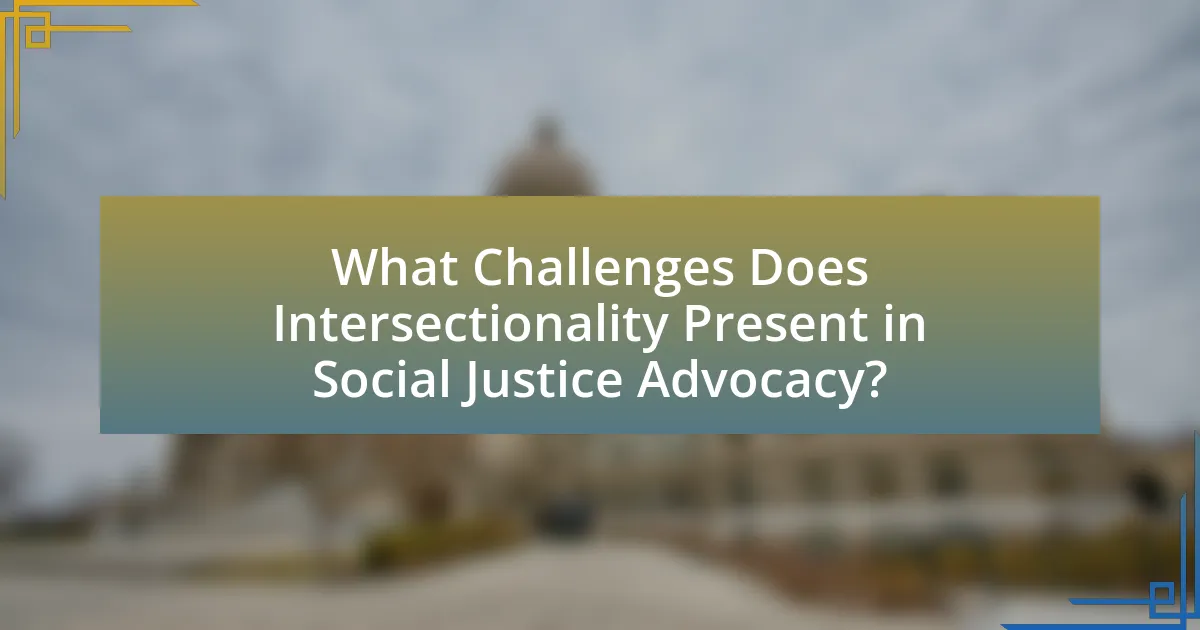
What Challenges Does Intersectionality Present in Social Justice Advocacy?
Intersectionality presents several challenges in social justice advocacy, primarily due to the complexity of overlapping identities and experiences. Advocates often struggle to address the unique needs of individuals who belong to multiple marginalized groups, which can lead to fragmented approaches that fail to encompass the full spectrum of discrimination faced. For instance, a study by Crenshaw (1989) highlighted how Black women experience discrimination differently than Black men or white women, illustrating the necessity for tailored advocacy strategies. Additionally, intersectionality can complicate coalition-building among diverse groups, as differing priorities and experiences may lead to conflicts or misunderstandings. This complexity necessitates a more nuanced understanding of social justice issues, which can be resource-intensive and challenging to implement effectively.
What are the common misconceptions about intersectionality in advocacy?
Common misconceptions about intersectionality in advocacy include the belief that it solely focuses on identity categories, neglecting systemic power dynamics. Many advocates mistakenly think intersectionality is only about adding identities together, rather than understanding how these identities interact to create unique experiences of oppression. Additionally, some believe that intersectionality is a divisive concept, when in fact it aims to foster inclusivity by recognizing diverse experiences within social justice movements. Research by Crenshaw, who coined the term, emphasizes that intersectionality highlights the interconnectedness of social categorizations and their collective impact on individuals’ lived experiences.
How can advocates address and overcome these misconceptions?
Advocates can address and overcome misconceptions by employing education and awareness campaigns that highlight the complexities of intersectionality. These campaigns can utilize data and personal narratives to illustrate how overlapping identities affect individuals’ experiences with social justice issues. For instance, research from the American Psychological Association indicates that individuals with multiple marginalized identities face unique challenges that are often overlooked, emphasizing the need for tailored advocacy strategies. By fostering dialogue and collaboration among diverse groups, advocates can dismantle stereotypes and promote a more nuanced understanding of social justice, ultimately leading to more effective advocacy efforts.
What are the risks of oversimplifying intersectional identities in advocacy?
Oversimplifying intersectional identities in advocacy risks erasing the complexities and nuances of individual experiences, which can lead to ineffective or harmful advocacy strategies. When advocates fail to recognize the interplay of various social identities—such as race, gender, sexuality, and class—they may inadvertently perpetuate stereotypes or marginalize certain groups within broader movements. For instance, a study by Crenshaw (1989) highlights how Black women face unique challenges that are not addressed by feminist or anti-racist movements that focus solely on gender or race, respectively. This lack of nuanced understanding can result in policies that do not adequately address the needs of all community members, ultimately undermining the goals of social justice advocacy.
How can advocates navigate conflicts that arise from intersectional perspectives?
Advocates can navigate conflicts arising from intersectional perspectives by employing active listening and fostering inclusive dialogue. Active listening allows advocates to understand the diverse experiences and needs of individuals from various backgrounds, which is essential in addressing the complexities of intersectionality. For instance, research by Crenshaw (1989) highlights how overlapping social identities can lead to unique forms of discrimination, necessitating a nuanced approach to advocacy. By facilitating inclusive dialogue, advocates can create spaces where all voices are heard, promoting collaboration and reducing tensions among different groups. This approach not only acknowledges the multifaceted nature of identity but also empowers marginalized communities to articulate their specific concerns, ultimately leading to more effective and equitable advocacy outcomes.
What tools can be used to mediate disagreements among diverse groups?
Mediation tools that can be used to resolve disagreements among diverse groups include facilitated dialogue, conflict resolution training, and collaborative problem-solving techniques. Facilitated dialogue involves a neutral third party guiding discussions to ensure all voices are heard, which is essential in diverse settings where perspectives may differ significantly. Conflict resolution training equips individuals with skills to manage disputes constructively, fostering understanding and respect among group members. Collaborative problem-solving techniques encourage participants to work together to find mutually beneficial solutions, promoting inclusivity and shared ownership of outcomes. These tools have been shown to enhance communication and reduce tensions, making them effective in mediating disagreements in diverse groups.
How can advocates foster collaboration among intersectional identities?
Advocates can foster collaboration among intersectional identities by creating inclusive spaces that prioritize diverse voices and experiences. This involves actively engaging individuals from various backgrounds in decision-making processes, ensuring representation in leadership roles, and facilitating dialogue that acknowledges and respects the complexities of identity. Research indicates that initiatives promoting intersectional collaboration, such as the “Intersectionality in Action” framework developed by the Center for Intersectionality and Social Policy Studies, demonstrate that inclusive practices lead to more effective advocacy outcomes. By implementing these strategies, advocates can build solidarity and enhance collective action across different identity groups.
What best practices can enhance the effectiveness of intersectional advocacy?
Best practices that enhance the effectiveness of intersectional advocacy include actively engaging diverse voices, fostering collaboration among marginalized groups, and utilizing data-driven approaches to inform strategies. Engaging diverse voices ensures that advocacy efforts reflect the complexities of various identities and experiences, which is crucial for addressing systemic inequalities. Collaboration among marginalized groups amplifies collective power and creates a unified front against oppression, as seen in successful movements like Black Lives Matter, which integrates various social justice issues. Utilizing data-driven approaches, such as intersectional data collection, allows advocates to identify specific needs and measure the impact of their initiatives, thereby enhancing accountability and effectiveness.
How can continuous education on intersectionality improve advocacy efforts?
Continuous education on intersectionality can significantly enhance advocacy efforts by equipping advocates with a nuanced understanding of how various social identities intersect and impact individuals’ experiences. This understanding allows advocates to tailor their strategies to address the specific needs of marginalized groups more effectively. For instance, research by Crenshaw (1989) highlights that individuals who belong to multiple marginalized identities face unique challenges that are often overlooked in traditional advocacy approaches. By integrating continuous education on intersectionality, advocates can develop more inclusive policies and practices that reflect the complexities of social justice issues, ultimately leading to more effective and equitable outcomes.
What role does community engagement play in successful intersectional advocacy?
Community engagement is essential for successful intersectional advocacy as it fosters inclusivity and amplifies diverse voices. Engaging with various community members ensures that advocacy efforts address the unique needs and experiences of different groups, particularly those at the intersections of multiple identities, such as race, gender, and socioeconomic status. Research indicates that initiatives incorporating community input are more effective; for instance, a study by the Urban Institute found that community-driven approaches lead to better outcomes in social programs by increasing trust and participation. Thus, community engagement not only enhances the relevance of advocacy efforts but also strengthens the collective impact by ensuring that all affected voices are heard and represented.
